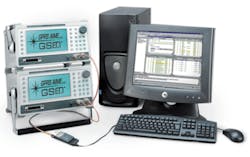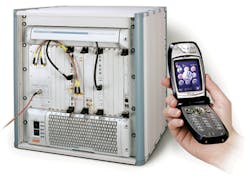Comm Test – Wireless Test – Conformance Test for GSM/UMTS Phones
The overall certification process may seem very long and involved, but it does provide a high level of uniformity across the industry.
The expectations for quality of service provided by mobile-phone systems are very high these days. Users anticipate that when they turn on their phones they will obtain flawless service. For GSM, they expect to roam across the globe and receive the same level of service that they do at home. Or, they will be able to drop a SIM card into any phone and experience no problems, regardless of the network. It is the successful operation of these features and many more that has lead to the phenomenal success of GSM that now has more than a billion subscribers worldwide.
The high levels of quality are by no means easy to achieve, especially when the degree of complexity of mobile phones and mobile-phone networks is considered. As an indication of the complexity, the original specifications for the GSM system consisted of many thousands of pages, and since then, further features have been added.
Handoff and other scenarios must be defined very precisely and operate correctly. For UMTS, intersystem handoff needs to be accommodated so mobiles can revert to the 2G or 2.5G systems when no 3G system is available and vice versa.
Ensuring that all the facilities work correctly before a phone is introduced into the market is essential. Adopting a test methodology that enables phones to operate on any network in any country means that they have to be tested to ensure they conform to the standards. This conformance testing is at the heart of the success of the GSM system.
Following on from GSM, a very similar approach has been adopted by the 3G UMTS or the WCDMA system. It is anticipated that a similar degree of success will be achieved.
Testing
Several different areas comprise the overall testing of a new mobile phone. Safety, RF absorption, protocols, RF performance, SIM or USIM, and audio performance are essential elements that need to be included in the overall program of tests.
Any piece of electrical equipment must be safe to use and operate. Mobile phones are no exception and must undergo rigorous safety tests to ensure that they will not cause harm or injury in any way. Although there have been a few reports of occurrences such as exploding batteries, these are very few and usually are attributed to third-party replacement batteries. Problems of this type are very rare and show how well the systems and individual devices work.
Another form of safety testing is undertaken to ensure that the level of RF absorption falls below the maximum permitted levels. The testing, known as SAR testing, involves the use of an anatomically correct model of the human head. Inside the model are sensors to measure the temperature rise.
The figures obtained can be related to the levels of RF radiation that are being absorbed at different places on the head. With the continuing awareness and concern of possible harmful effects of radiation, this is a key test.
Protocol testing determines the overall operation of the phone. If the phone protocol software operates incorrectly, then it is likely that the phone will not operate properly on a network. There even have been instances when the incorrect operation of phones has caused problems with a network.
In view of the complexity of the protocols that are used, this testing can be very involved and requires the use of specialized network simulators. These testers emulate a variety of network entities, such as BTS, BSC, or in the case of UMTS, Node Bs and RNC. In this way, a host of scenarios from registering to terminating a call and all the different forms of handoff can be simulated. In fact, any situation that can be encountered needs to be fully tested.
The RF performance of the phone also must be checked. Many measurements of the transmitter and receiver performance are carried out in a variety of areas including the out-of-band emissions. Measurements of the RRM are carried out to ensure that the control capability of the phone is operating correctly. The RRM is the entity used to control the physical or RF layers in accordance with the requirements of the protocols from the higher layers.
There are, for instance, very tight limits on the transmitter output power as it is controlled to meet conditions such as variations in signal strength. This ensures that the phone only transmits sufficient power to maintain a reliable circuit under the prevailing conditions, and as a result, the overall level of noise in the phone bands is reduced to the minimum level.
Another critical area of testing involves the SIMs used in GSM phones or the USIMs used in UMTS. These cards are interchangeable between phones, and it is essential that the interface is checked rigorously to ensure that it will work with any SIM or USIM.
It also is vital to check the security aspects since any lapses could compromise elements of the network security. A SIM simulator or USIM simulator is required to emulate the operation of the SIM, and tests on the phone then can be run using a protocol tester.
Finally, audio checks need to be completed. These ensure that the audio aspects of the phone meet the required standards both in terms of the microphone and earphone. A wide variety of checks is performed to ensure that audio characteristics are satisfactory under all conditions.
Test Cases
All testing performed on a mobile must be repeatable and conform to the specifications regardless of the test equipment being used. To achieve this, formal test cases are written for each test. For GSM, these originally were defined by ETSI but now are controlled by 3GPP.
A variety of processes can be adopted for writing test cases. For GSM, test cases are written in prose, describing in detail the test setup, the stimuli that need to be applied, the way in which the test is carried out, and the pass and fail criteria. To ensure that each test is a true representation of the original intent of the test, a validation and certification process has been set in place.
Once the manufacturer is satisfied that the test operates correctly, it then is given to an independent validation organization to test for conformance with the original test specification and check for proper operation. Once it has passed this test, it can be submitted to the relevant industry body for certification. After certification, it can be used in formal handset testing.
The 3GPP has overall control of the test cases for GSM and UMTS. Changes, however, are handled by the GERAN Working Group for GSM. For UMTS, changes are addressed by the T1 Group. The validation and approval of the implemented test cases then are handled by the GCF.
The North American version of GSM running in the 1,900-MHz band often is referred to as PCS, and now there is another allocation at 850 MHz. A group known as PVG handles the approvals, and its results are ratified by the PTCRB. Phones then are tested against the test cases that, if successful, are certified by the CTIA. To achieve CTIA certification, it is necessary for phones to be tested in CTIA-approved laboratories.
UMTS Test Cases
The experiences and lessons learned through GSM have resulted in a number of changes to the way in which test cases are generated for UMTS. Protocol test cases for UMTS were written in prose and then converted into TTCN code. This language enables the test cases to be compiled by a computer into a format that can be run directly on the target test equipment.
This approach saves time for the industry as a whole and reduces costs because generating the test cases is far easier. It also gives far more consistency across the industry because tests no longer are open to the same level of interpretation that they were before. As a result, time is saved during the validation process.
The TTCN test cases have been prepared by a team of industry experts based at ETSI working on behalf of the 3GPP. The team developed the basic TTCN code that was reviewed within the 3GPP community using e-mail reflectors. By reviewing the software at the beginning of the process, the individual test cases do not need to be reviewed each time they are submitted by a test-equipment manufacturer for validation.
To test a new handset, the manufacturer generally approaches a qualified test house. The test house will run the required certified test cases and state that the handset is suitable for use on the available networks.
Summary
Although the overall certification process may seem very bureaucratic and long, it has resulted in an exceedingly high level of uniformity across the industry. This has been part of the success of the GSM system and, no doubt, will be part of the success of UMTS.
Phone manufacturers have shared in this success because, once certified, their phones should operate on any network. This greatly increases the markets that are open to them.
About the Authors
Ian Poole, a consultant at Aeroflex, is a chartered engineer and fellow of the Institution of Electrical Engineers. He obtained his degree from University College London. Mr. Poole also has authored more than 18 books and many articles worldwide for which he has won awards. e-mail: [email protected]
Phil Medd is a product manager for Racal Instruments Wireless Solutions, supporting the 3G mobile protocol test products. Mr. Medd graduated from Nottingham University in 1977 with a degree in electrical and electronic engineering and since then has worked in the test-equipment industry. e-mail: [email protected]
Racal Instruments Wireless Solutions, an Aeroflex company, 480 Bath Rd., Burnham, Berkshire SL1 6BE UK, 011 44 (0) 1628 604455




